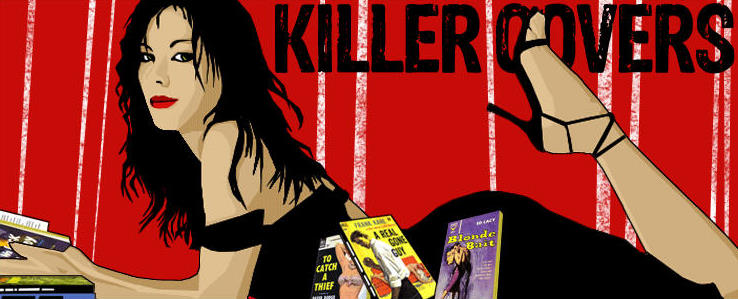 (Above) Robert McGinnis’ “forgotten” Florinda front.
(Above) Robert McGinnis’ “forgotten” Florinda front.
When Randal S. Brandt, a librarian at the University of California, Berkeley, went looking for background on Dana Wilson, the author of a peculiarly titled 1946 novel,
Make with the Brains, Pierre, that he had acquired for the library’s
California Detective Fiction Collection, he discovered there was more mystery in the writer’s identity than there was in Wilson’s “grim tale of psychological suspense.” As he explained recently for The Rap Sheet:
The book itself, including the original dust jacket, was no help at all. There is no author’s biography, photograph, or blurb on this edition. I didn’t even know if Dana was a man or a woman ..., or whether the name was real or a pseudonym. The Library of Congress, usually the authority on matters of book authorship, was no help whatsoever here. In its catalogue, the novel was entered under the simple heading of “Wilson, Dana,” which was linked to a composer and professor of music born in 1946. Nope, definitely not the author of this 1946 novel. The database contained entries for several other similarly named writers, but none were the one I was looking for. Disambiguating authors from one another and identifying them with the works that they produce is called, in library parlance, “authority control” and is a critical component of cataloguing, so I was determined to do something to distinguish Dana Wilson the mystery writer from the other Dana Wilsons.
Eventually, thanks to help from the genealogical database Ancestry, a vague dedication in the novel’s opening pages, and a soupçon of good fortune, Brandt succeeding in finding his answers. Wilson, it turns out, was a New York-born Hollywood actress who, following her divorce from
Lewis Wilson—the first man ever to
play Batman on film—went on to marry
Albert R. “Cubby” Broccoli, one of two partners (
Harry Saltzman being the other) now famous for bringing Ian Fleming’s James Bond novels to life on the silver screen.
Despite her modest success with
Make with the Brains, Pierre (republished in paperback during the late 1940s as
Scenario for Murder and
Uneasy Virtue),
Dana Broccoli produced only one more book: the 1977 hardcover release
Florinda. Brandt describes it as “a historical novel set in 8th-century Spain, which was apparently inspired while [she and Cubby were] scouting locations for the Bond series.” The story’s protagonist is
Florinda la Cava, or simply La Cava, said by Wikipedia to have “played a central role in the downfall

of the Visigothic kingdom in Spain in 711. Although she was treated as historical in Spain for centuries, there is no evidence for her existence whatsoever and her name is certainly a later concoction.”
(Right) Dana Broccoli’s author portrait from the historical yarn Florinda.
Mere legend Florinda may be—the lover (or else the rape victim) of the last Visigothic king,
Roderic, whose powerful father sought to avenge that dishonor by siding with Muslim conquerors against Roderic—but she appears every inch the callipygous seductress in the cover illustration for Broccoli’s
Florinda shown atop this post, painted by renowned paperback and movie poster artist
Robert McGinnis. How McGinnis came to be hired by Broccoli’s small publisher, Two Continents, to create that book front is a story now lost to time. The artwork itself has been largely forgotten, as well.
“Wow, Jeff! That’s an impressive piece,” replied Tim Hewitt, a former tech writer and paperback collector in South Carolina, after I asked him to confirm the identity of
Florinda’s cover creator. “Yes, it’s McGinnis! After some close examination, I’m confident that’s McGinnis’ signature (
what you can see of it) just below Dana Broccoli’s name on the cover. And honestly, if this isn’t McGinnis I’ll eat my hat, as the old saying goes.”
Art Scott, the co-author (with the painter himself) of 2014’s
The Art of Robert E. McGinnis, concurs. “[A]s a self-made McGinnis authority,” he wrote me in a recent e-mail note, “I’ll sign off on this one as being genuine McGinnis. I also checked through my file of photos of the paintings held by Bob when we were working on the book, but didn’t expect to find
Florinda—and didn't. I imagine it’s in the hand of the Broccoli heirs.”
Available copies of Broccoli’s novel are few and far between, and vary in price. Checking today, for instance, I see two to be had on the
AbeBooks Web site—one going for a modest $33.75, the other valued at $150, both described as being in “
fine” (or “as new”) condition. For a committed McGinnis fan, though, one to whom this art was previously unknown, cost may be of little significance.























